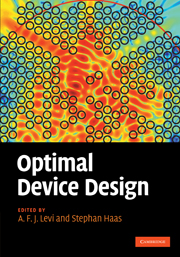Book contents
- Frontmatter
- Contents
- Preface
- Acknowledgements
- 1 Frontiers in device engineering
- 2 Atoms-up design
- 3 Electron devices and electron transport
- 4 Aperiodic dielectric design
- 5 Design at the classical–quantum boundary
- 6 Robust optimization in high dimensions
- 7 Mathematical framework for optimal design
- 8 Future directions
- Appendix A Global optimization algorithms
- About the authors
- Index
- References
6 - Robust optimization in high dimensions
Published online by Cambridge University Press: 04 May 2010
- Frontmatter
- Contents
- Preface
- Acknowledgements
- 1 Frontiers in device engineering
- 2 Atoms-up design
- 3 Electron devices and electron transport
- 4 Aperiodic dielectric design
- 5 Design at the classical–quantum boundary
- 6 Robust optimization in high dimensions
- 7 Mathematical framework for optimal design
- 8 Future directions
- Appendix A Global optimization algorithms
- About the authors
- Index
- References
Summary
Introduction
Optimization has a distinguished history in engineering and industrial design. Most approaches, however, assume that the input parameters are precisely known and that the implementation does not suffer any errors. Information used to model a problem is often noisy, incomplete or even erroneous. In science and engineering, measurement errors are inevitable. In business applications, the cost and selling price as well as the demand for a product are, at best, expert opinions. Moreover, even if uncertainties in the model data can be ignored, solutions cannot be implemented to infinite precision, as assumed in continuous optimization. Therefore, an “optimal” solution can easily be sub-optimal or, even worse, infeasible.
There has been evidence illustrating that if errors (in implementation or estimation of parameters) are not taken into account during the design process, the actual phenomenon can completely disappear. A prime example is optimizing the truss design for suspension bridges. The Tacoma Narrows bridge was the first of its kind that was optimized to divert the wind above and below the roadbed [1]. Only a few months after its opening in 1940, it collapsed due to moderate winds which caused twisting vibrational modes. In another example, Ben-Tal and Nemirovski demonstrated that only 5% errors can entirely destroy the radiation characteristics of an otherwise optimized phased locked and impedance matched array of antennas [2]. Therefore, taking errors into account during the optimization process is a first-order effect.
Traditionally, sensitivity analysis was performed to study the impact of perturbations on specific designs and to find solutions that are least sensitive among a larger set of optima.
- Type
- Chapter
- Information
- Optimal Device Design , pp. 149 - 188Publisher: Cambridge University PressPrint publication year: 2009



